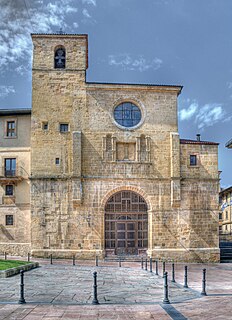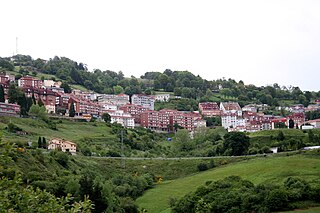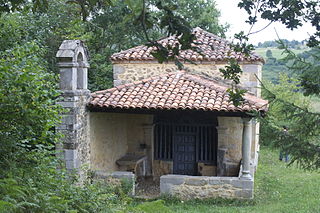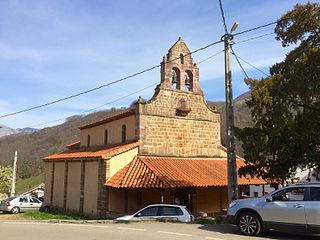
Asturias, officially the Principality of Asturias, is an autonomous community in northwest Spain.

Covadonga is one of 11 parishes in Cangas de Onís, a municipality within the province and autonomous community of Asturias, in Northwestern Spain. It is situated in the Picos de Europa mountains. With a permanent population of 58 (2008), it consists essentially of the "Real Sitio de Covadonga"/"Real Sitiu de Cuadonga" also known as the "cradle of Spain", a pilgrimage site dedicated to Our Lady of Covadonga/Cuadonga and commemorating the Battle of Covadonga of 718/722.

Silo was the king of Asturias from 774 to 783, succeeding Aurelius. He came to the throne upon his marriage to Adosinda, daughter of Alfonso I. He moved the capital of the Kingdom of Asturias from Cangas de Onís to Pravia, closer to the center of the kingdom. He was a contemporary of Abd al-Rahman I, Umayyad Emir of Córdoba, and of Charlemagne.

Cangas de Onís is a municipality in the eastern part of the province and autonomous community of Asturias in the northwest of Spain. The capital of the municipality is also Cangas de Onís.

San Vicente de Oviedo is a church and monastery in Oviedo, Spain. Its foundation, in 761, is recorded in a charter known as the Pacto monástico de Oviedo a copy made in the 12th century of the original that is dated 25 November 781 and is considered the earliest document on the monarchy of the Kingdom of Asturias, although doubts exist as to the veracity of this document since the monastery, also called Antealtares in the Middle Ages, is not mentioned again until 969. According to the charter of 781, twenty years before, in 761, the monks Máximo, with his serfs, and Fromestano, founded a church in locum quod dicunt Oveto, which was to become the city of Oviedo. Fromestano and Maximo are considered the founders of the city and church. Fromestano in the charter of 781, describes its founding:
I, Frómista (Fromestano), abbot for the past twenty years, together with my nephew Máximo the monk, settled in this place, abandoned and uninhabited, founding a basilica in honor of Saint Vincent, a martyr of Christ and a deacon.

Benavente is a town and municipality in the north of the province of Zamora, in the autonomous community Castile and León of Spain. It has about 20,000 inhabitants.

Tineo is a concejo (municipality) in the Principality of Asturias, Spain. It is situated on a small tributary of the Narcea River. It is the second-largest municipality in Asturias. It is bordered to the north by Valdés, to the south by Cangas del Narcea, to the west by Villayón and Allande, and to the east by Salas, Belmonte de Miranda and Somiedo.

Muxía is a coastal town and municipality in the province of A Coruña in the autonomous community of Galicia in northwestern Spain. It belongs to the comarca of Fisterra. It is one of the final destinations for pilgrims on the Way of St. James after visiting the shrine of the apostle Saint James the Great in Santiago de Compostela.

The Victory Cross is an early 10th century Asturian crux gemmata or jewelled cross, given by King Alfonso III of Asturias, who reigned from 866 to 910, to the Cathedral of San Salvador of Oviedo. It was made in 908 in the Castle of Gauzón . At the core is an oakwood cross, in legend identified with a cross carried by King Pelagius of Asturias at the Battle of Covadonga.

Santa Cruz de Cangas de Onís is a small Roman Catholic chapel in Cangas de Onís, the first capital of the Kingdom of Asturias, in what is now northern Spain. It was founded on an artificial mound by Favila, second king of Asturias, and his queen, Froiliuba. It was begun in 737 and consecrated that same year on 27 October according to its original foundation stone, which has been called the first literary monument of the Reconquista.

The Abbey of San Juan Bautista de Corias is a former Benedictine monastery in Corias in Cangas del Narcea (Asturias), Spain, on the right bank of the Narcea River, dedicated to Saint John the Baptist. Today it is a historic site of the province, informally known as "the Asturian Escorial", due to the burial there of King Bermudo I of Asturias and his family.

San Pedro is a Romanesque-style Roman Catholic church in the Mestas de Con neighborhood of Cangas de Onís, in the community of Asturias, Spain.

Santa Cruz is a Pre-Romanesque Roman Catholic church located in Cangas de Onís, in Asturias, Spain.

Capilla de Santa Eugenia de Sobrecueva is a church in Asturias, Spain.

Basílica de Santa María la Real de Covadonga is a Catholic church located in Covadonga/Cuadonga, Cangas de Onís/Cangues d'Onís, Asturias, Spain, that was designated as basilica on September 11, 1901.

The Church of Santa María de Villanueva is a Romanesque-style, Roman Catholic parish church in the diocese of Villanueva, in the municipality of Teverga, community of Asturias, Spain.

Monasterio de Santa María de Villanueva de Oscos is a monastery in Asturias, Spain. It was founded in the 12th century as a Benedictine house.

The Santa Cueva de Nuestra Señora de Covadonga is a Catholic sanctuary located in Asturias, northern Spain. It is a cave in the Picos de Europa mountains, which gives its name to the parish of Covadonga in the municipality of Cangas de Onís. The name refers to the sanctuary, dedicated to the Virgin of Covadonga, where the first battle of the Spanish Reconquest took place in 718.

Ermesinda alternatively Ormisenda, Ermisenda, Ermesinde, Ermessenda) was queen consort of the Kingdom of Asturias, wife of King Alfonso I of Asturias. She was the daughter of King Pelagius of Asturias and his queen, Gaudiosa.



















